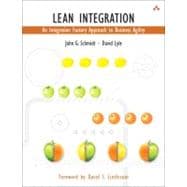
What is included with this book?
List of Figures and Tables xv
Foreword xix
Preface xxiii
Acknowledgments xxvii
About the Authors xxix
Introduction xxxi
Part I: Executive Summary 1
Chapter 1: What Is Lean Integration and Why Is It Important? 3
Constant Rapid Change and Organizational Agility 5
The Case for Lean Integration 9
What Is Integration? 11
Integration Maturity Levels 14
Economies of Scale (the Integration Market) 16
Getting Started: Incremental Implementation without “Boiling the Ocean” 20
Chapter 2: A Brief History of Lean 23
The Lean System 29
The Lean Practices 34
Lean Application Trends 41
Case Study: The Value of Lean in Service Industries 44
Chapter 3: The Integration Factory 45
What Is an Integration Factory? 46
The Integration Factory as an Element of an ICC 52
How Does the Integration Factory Work? 55
Integration Factories as Self-Service ICCs 64
Part II: Applying Lean Principles 67
Chapter 4: Focus on the Customer and Eliminate Waste 69
Focus on the Customer 70
Integration Wastes 74
Case Study: Waste Elimination at Clicks-and-Bricks 81
Case Study: Waste Elimination at Big Bank 85
Focus on the Integration Value Chain 87
Chapter 5: Continuously Improve 89
Continuous Learning and Knowledge Management 90
Case Study: Continuous Improvement at Clicks-and-Bricks 91
Chapter 6: Empower the Team 103
What Is a Team? 104
Examples of Empowered Teams in Software 107
Creating an Empowered Lean Integration Team 109
Leadership and Vision 112
Important Practices That Help Enable Empowered Teams 117
Organizing the Team: Thoughts on Organizational Structures 120
Case Study: Smith & Nephew–Integrating Lean Principles with Data Quality 122
Chapter 7: Optimize the Whole 131
Optimize the Whole Rather than Optimize the Parts 132
What Is “the Whole”? An Introduction to Value Stream Mapping 134
Selecting Metrics to Optimize the Whole 139
Chapter 8: Plan for Change and Mass-Customize 145
Techniques for Enabling Constant Change 146
Mass Customization 152
Case Study: Using Mass Customization 159
Chapter 9: Automate Processes and Deliver Fast 163
Pitfalls of Automation–Building “Stuff” Faster 164
Delivering Fast 167
Automating Processes–Using the Computer to Make Complexity Manageable 169
Case Study: Automating Processes at Wells Fargo Home Mortgage 174
Chapter 10: Build Quality In 181
Two Areas of Quality: Data Quality and Integration Quality 182
Quality Evolution and Lean 184
Data Quality 185
Integration Quality 192
Case Study: Building Quality In at a Utility Company ICC 198
Part III: Implementation Practices 203
Chapter 11: Financial Management 205
Challenges 207
Activities 214
Business Case Development 215
Case Study: A “Creating the Wave” Investment Strategy 236
Case Study: Enterprise Data Warehouse Rationalization Business Case 238
Chargeback Accounting 240
Chargeback Case Studies 250
Chapter 12: Integration Methodology 253
Activities 256
Agile versus Lean Methodology 263
Case Study in Simplicity: The Architecture of the Web and REST versus SOA 269
Engagement Services Management 271
Case Study: Integration Methodology in a Decentralized Enterprise 274
Chapter 13: Metadata Management 281
Metadata Scope for Lean Integration 284
Metadata Management Framework 285
Challenges 289
Prerequisites 292
Industry Practices 293
Activities 295
Chapter 14: Information Architecture 301
Challenges 304
Prerequisites 308
Activities 309
Methodology 310
Information Architecture Models 312
Data at Rest 317
Chapter 15: Business Process Management 321
Data-in-Motion Models 324
Activities 326
Architecture 328
Case Study: The Post Closing Systems Architecture 330
Chapter 16: Modeling Management 333
Service-Oriented Architecture Can Create a New Hairball 336
Challenges 339
Coupling and Cohesion Framework 343
Canonical Modeling Techniques 345
Navigating the Modeling Layers 350
Activities 352
Case Study: European Interoperability Framework 357
Case Study: Object-Relational Mismatch 359
Chapter 17: Integration Systems 361
What Is an Integration System? 362
Integration Systems Taxonomy 364
Challenges 369
Industry Practices 370
Activities 371
Portfolio Rationalization 378
Appendix A: Lean Terminology 387
Appendix B: Integration Laws 395
Law #1: The Whole Is Greater than the Sum of Its Parts 395
Law #2: There Is No End State 396
Law #3: There Are No Universal Standards 396
Law #4: Information Adapts to Meet Local Needs 397
Law #5: All Details Are Relevant 397
Appendix C: Glossary 399
Common Acronyms 399
Definitions 400
Index 409
The New copy of this book will include any supplemental materials advertised. Please check the title of the book to determine if it should include any access cards, study guides, lab manuals, CDs, etc.
The Used, Rental and eBook copies of this book are not guaranteed to include any supplemental materials. Typically, only the book itself is included. This is true even if the title states it includes any access cards, study guides, lab manuals, CDs, etc.